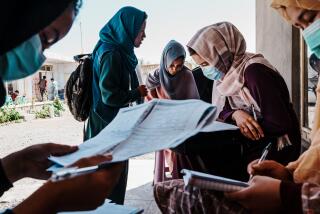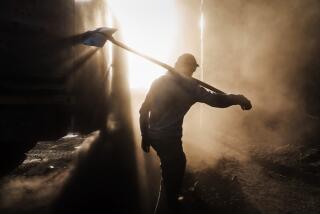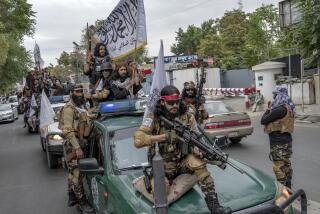Pakistan troops battle Taliban in the Sakhra Valley
SAKHRA VALLEY, PAKISTAN — At a remote base camp in the heart of the Swat Valley, Pakistani army troops are hunkered down in a temporary compound, a large private home whose owner recently fled the advancing warfare.
It is the third day of a nine-day operation to clear an area known as the Sakhra Valley, and the soldiers remain under attack by Taliban fighters who had made it one of their strongholds.
Bullet holes riddle the living room windows and shattered glass covers the floors. From the balcony, soldiers fire back, using binoculars to spot enemy positions. In the courtyard, sandbags are filled to fortify broken walls and build sniper posts.
Battles such as the one last Thursday -- of which a Times photographer traveling with Pakistani troops received a rare firsthand glimpse -- can prove costly. More than 40 Pakistani soldiers have been killed in recent fighting to retake control of central and upper Swat from Islamic militants who had terrorized residents unwilling to accept their harsh Islamic justice system. Authorities say about 500 militants also have died in the fighting in this onetime tourist haven just 100 miles from the nation’s capital, Islamabad.
In February, the Pakistani government had agreed to allow the Taliban here to enforce Sharia, or Islamic law, if the militants would stop such acts of violence as beheading local officials and paramilitary troops who spoke out against them. Within weeks, however, the Taliban expanded into neighboring Buner district, setting up checkpoints and ordering the strict enforcement of Sharia.
More than 20,000 Pakistani troops have since been committed to rooting out the Taliban.
In the Swat Valley, the army’s game plan is to enter small villages and valleys off the main north-south road and attempt to rid them of militants before moving on to the next community.
Weeks of heavy fighting in towns such as Mingora and Matta have forced the Taliban into more remote valleys such as Sakhra, surrounded by snowcapped mountains.
Because of the lush green terrain and deep canyons, some call the area the Switzerland of Pakistan, where farmers grow wheat and where apple and peach trees are plentiful. But the picturesque landscape favors the guerrillas, many of them Swat Valley residents. The fighters are knowledgeable about the battleground, light on their feet and can often outrun the more cumbersome government forces.
“It is very difficult to control their movements in this terrain,” says Brig. Suba Khan, in command of the Sakhra Valley operation. “When you enter these valleys, you need more boots on the ground. Our people have to go out on foot, to physically walk up these mountains.”
The army, while seemingly strong in number and organization, is also hampered by a dearth of armored vehicles, night-vision goggles and sufficient air support.
Lt. Col Ashraf Adil Naveed commands the four units here, including the 50 troops inside the house and the 100 men positioned in the surrounding woods, who will remain there throughout the night.
“This area is very difficult from a military point of view,” he says. “We don’t have night vision, so this operation will take twice as long. There is a hard fight going on. This is the first time any armed forces have been in this area. We have been fighting 72 hours straight, and three of our men have been killed.”
During a lull, Naveed explains that the Taliban is “using very expensive weapons, which are not available for sale in Pakistan. The question is, who is paying for these weapons? They are surely being supported by foreigners.”
Militants also make use of everyday household items: pressure cookers, like those for making stew, with holes drilled in the top so they can be wired for manual detonation. Troops have found a carefully handwritten notebook containing the simple recipe for improvised explosive devices, or IEDs.
Booby-traps awaited Naveed’s men on the narrow, winding road through the Sakhra Valley. Two large craters have been created by IEDs and a bridge has been blown up. A few yards beyond, in the village of Shamay, stands a house that was filled with explosive materials -- a literal IED factory -- including open sacks of explosive powder.
The Pakistani army rides in light, open jeeps, fully exposed to fire and fragments from any blast. As the convoy moves, a loud whistle is blown to warn civilians to move from the road as they pass.
“We have very soft vehicles,” says Khan, the brigadier. “This is one of our weaknesses. Any attack can cause casualties.”
Two days later, seven soldiers were killed in an IED explosion nearby.
Soldiers standing guard at the house, which serves as the forward operating base, halt two civilians, checking their bundles at gunpoint. After reloading the cargo on a donkey, the civilians walk on with their hands held high in the air.
“The people from this region are uneducated and poor. They [the Taliban] offer them a lot of money, some 10,000 rupees per month, for help,” Naveed says. “It’s difficult to identify our enemy because they are wearing civilian clothes.”
At daybreak, foot soldiers who have gotten little sleep gather in the courtyard, resting against walls before the day’s mission begins. Orders are given to push on to the next village and clear out more militants. Before leaving, the men stand in formation to be led in prayer.
During 19 months of serving in Swat operations, Lt. Col. Abdul Rehman, 41, has seen success and failure. Back at headquarters in the town of Khwazakhela, he commands his men with relaxed confidence from a large tent set up in the front yard of what was once a college. Phones, maps and charts line the inside wall. Wandering the grounds are two large turkeys and a dozen white rabbits, along with sheep that feed on the grassy helicopter pad when it’s not in use.
“The battlefield has changed. It’s modern warfare now. As a nation, we should fight it out. If there is no stabilizing force, these people [the militants] are like rabid dogs. We are to be blamed for leaving a vacuum here. I don’t blame the West. We failed to look after our own interests. It took eight years for us to realize that the Taliban is our enemy.”
Not 20 feet away, more than 30 militants, blindfolded, are being held in a second-floor classroom. The sound of clanking chains can be heard as they are led from room to room.
Some are young fighters, others old men. All are accused of providing aid to or harboring terrorists. Some have long white beards; others, short hair. A few have shaved in an effort to blend into the general population.
Dark clouds roll into the area. The sound of thunder is hard to distinguish from that of artillery fired nearby, aimed at positions higher up the Sakhra Valley, softening the way for the army’s advance.
“This valley is filled with people who want to stay on their land,” says Naveed, the lieutenant colonel. “They are living under terror. We hope to eliminate these bad people. We are people of peace, and we don’t like what is happening to our country.”
--
More to Read
Sign up for Essential California
The most important California stories and recommendations in your inbox every morning.
You may occasionally receive promotional content from the Los Angeles Times.











